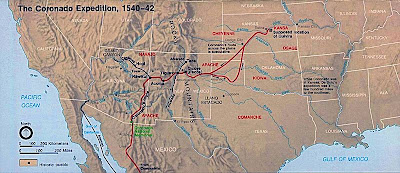 |
| Coronado Heading North by Frederic Remingto |
As part of your New Mexico vacation or side trip to the Zuni Pueblo, there are some sites that are must sees. One is the Old Zuni Mission. The mission lies in the center of the Zuni Pueblo. The Spanish Franciscan friars constructed the mission is 1629 and named it Our Lady of Guadalupe Church. The mission turned into ruins over the centuries but was restored in 1966. This mission is thought to be the best example of Spanish mission architecture in the entire southwest. Visitors from the world over have enjoyed viewing the life-size murals of Zuni Kachina figures. The work was done by Alex Seowtewa and his sons. The Pueblo Native Americans were expert artisans and created many excellent art and jewelry pieces. Zuni pottery and pueblo pottery has a long tradition having been practiced for over a thousand years. The Zuni tribe of New Mexico is also known for their elaborate jewelry. The Zuni Reservation is home to many of the artists who have been taught how to make jewelry,
 |
| Kachina dolls, Wikipedia |
Another must see site are the ruins of the village of Hawikuh which was a major historic site during Coronado's 1540 expedition. The ruins are a National Historic Landmark located 12 miles southwest of Zuni Pueblo. The site can be visited with a guide and permission from the Zuni tribal office. It is an excellent stop for the history minded traveler.
 |
| First terrace Zuni, NM, 1879 |
All of the Pueblo Indians including the Zuni are believed to be the descendants of the Ancient Pueblo civilization that resided in the desert southwest. This included the present states of Arizona, New Mexico, Utah and parts of Colorado. The Pueblo descendants lived in this area for many centuries. There was a trail that is referred to as The Trail of the Padres that ran from Mexico City into what is now new Mexico. This trail was so ancient that the Aztecs used it when they left the north and resettled in the valleys of Mexico where Cortez ultimately found them. The trail was said to be very old even when the Aztecs used it. The trail goes for some two thousand miles over mountains and through hot deserts and really has no end whereas it spreads it's offshoot trails to virtually all parts of the southwest. It was on this trail in 1539 that Fray Marcos guided by his negro slave Estevan traveled in search of the Seven Cities of Gold. The small expedition ended badly when Estevan went ahead into the Hawikuh Pueblo, believed to be the first city, and he was subsequently killed. Fray Marcos moved ahead but decided not to enter. The Fray did however return to tell stories of golden cities and this sent the Spaniards into an excited frenzy.
The first contacts the Pueblo people had with Europeans was during the Spanish exploration of America's southwest region. The expedition into the area began in 1540 and was led by Francisco Vasquez de Coronado. His expedition set out from the western coast of Mexico in search of "The Seven Cities of Cibola", the fable heard from Fray Marcos. This was also the tale told by the Aztecs who had previously lived in the north.
Coronado reached Hawikuh in 1540 and was met by Zuni warriors. A battle ensued and the village was taken by the Spaniards but not before the women and children had been evacuated to a stronghold called Thunder Mountain. Coronado sent Don Pedro de Tovar with a group to explore towards the northwest towards what is now the Four Corners area. Here Tovar met the hopi people who told him that across a large river to the west were giant people. Tovar did end up discovering the Grand Canyon but went no further and returned to Coronado's post. A historic side note is that the El Tovar Hotel built by The Atchison, Topeka & Santa Fe Railroad and Fred Harvey in the early 1900's on the Grand Canyon's south rim was named in his honor. Coronado decided to send Don Garcia Lopez de Cardenas to follow up on the Hopi's report. Cardenas however was never able to find a way to cross the Colorado River. Coronado of course never found his Seven Cities of Gold but the Spaniards did of course colonize most of the southwest and much of California until the Mexican Revolt in 1823-25.
Another important event whenever discussing the Pueblos of New Mexico and the Spaniards in the southwest was the Pueblo Revolt of 1680. This revolt actually drove the Spanish out of New Mexico for 12 years. During the widespread uprising some 21 friars were slain. The Spaniards returned 12 years later and were able to restore their rule under less strict conditions.
While vacationing in Arizona another good stop during your road trip is the Coronado National Memorial near Tucson Arizona. Located at the boundary between the United States and Mexico, the memorial shows the influences everywhere of its neighbor to the south.To get there from Phoenix or Tucson take I-10 east and exit south on Hwy. 90 to Sierra Vista. After reaching Sierra Vista, go south on Hwy. 92 about 20 miles to S. Coronado Memorial Drive. (From Bisbee, take Hwy 92 west). Follow S. Coronado Memorial Drive 5 miles to the Visitor Center.


